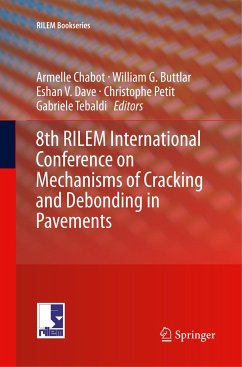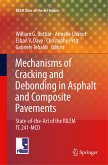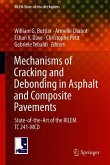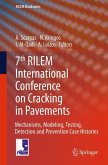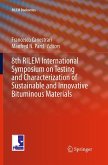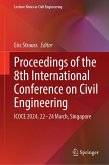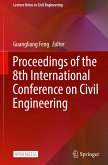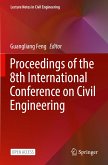8th RILEM International Conference on Mechanisms of Cracking and Debonding in Pavements
Herausgegeben:Chabot, Armelle; Buttlar, William G.; Dave, Eshan V.; Petit, Christophe; Tebaldi, Gabriele
8th RILEM International Conference on Mechanisms of Cracking and Debonding in Pavements
Herausgegeben:Chabot, Armelle; Buttlar, William G.; Dave, Eshan V.; Petit, Christophe; Tebaldi, Gabriele
- Broschiertes Buch
- Merkliste
- Auf die Merkliste
- Bewerten Bewerten
- Teilen
- Produkt teilen
- Produkterinnerung
- Produkterinnerung
This book presents the latest advances in research to analyze mechanical damage and its detection in multilayer systems. The contents are linked to the Rilem TC241 - MCD scientific activities and the proceedings of the 8th RILEM International Conference on Mechanisms of Cracking and Debonding in Pavements (MCD2016). MCD2016 was hosted by Ifsttar and took place in Nantes, France, on June 7-9, 2016. In their lifetime, pavements undergo degradation due to different mechanisms of which cracking is among the most important ones. The damage and the fracture behavior of all its material layers as…mehr
Andere Kunden interessierten sich auch für
![Mechanisms of Cracking and Debonding in Asphalt and Composite Pavements Mechanisms of Cracking and Debonding in Asphalt and Composite Pavements]() Mechanisms of Cracking and Debonding in Asphalt and Composite Pavements104,99 €
Mechanisms of Cracking and Debonding in Asphalt and Composite Pavements104,99 €![Mechanisms of Cracking and Debonding in Asphalt and Composite Pavements Mechanisms of Cracking and Debonding in Asphalt and Composite Pavements]() Mechanisms of Cracking and Debonding in Asphalt and Composite Pavements104,99 €
Mechanisms of Cracking and Debonding in Asphalt and Composite Pavements104,99 €![7th RILEM International Conference on Cracking in Pavements 7th RILEM International Conference on Cracking in Pavements]() 7th RILEM International Conference on Cracking in Pavements229,99 €
7th RILEM International Conference on Cracking in Pavements229,99 €![8th RILEM International Symposium on Testing and Characterization of Sustainable and Innovative Bituminous Materials 8th RILEM International Symposium on Testing and Characterization of Sustainable and Innovative Bituminous Materials]() 8th RILEM International Symposium on Testing and Characterization of Sustainable and Innovative Bituminous Materials150,99 €
8th RILEM International Symposium on Testing and Characterization of Sustainable and Innovative Bituminous Materials150,99 €![Proceedings of the 8th International Conference on Civil Engineering Proceedings of the 8th International Conference on Civil Engineering]() Proceedings of the 8th International Conference on Civil Engineering171,99 €
Proceedings of the 8th International Conference on Civil Engineering171,99 €![Proceedings of the 8th International Conference on Civil Engineering Proceedings of the 8th International Conference on Civil Engineering]() Proceedings of the 8th International Conference on Civil Engineering38,99 €
Proceedings of the 8th International Conference on Civil Engineering38,99 €![Proceedings of the 8th International Conference on Civil Engineering Proceedings of the 8th International Conference on Civil Engineering]() Proceedings of the 8th International Conference on Civil Engineering30,99 €
Proceedings of the 8th International Conference on Civil Engineering30,99 €-
-
-
This book presents the latest advances in research to analyze mechanical damage and its detection in multilayer systems. The contents are linked to the Rilem TC241 - MCD scientific activities and the proceedings of the 8th RILEM International Conference on Mechanisms of Cracking and Debonding in Pavements (MCD2016). MCD2016 was hosted by Ifsttar and took place in Nantes, France, on June 7-9, 2016. In their lifetime, pavements undergo degradation due to different mechanisms of which cracking is among the most important ones. The damage and the fracture behavior of all its material layers as well as interfaces must be understood. In that field, the research activities aims to develop a deeper fundamental understanding of the mechanisms responsible for cracking and debonding in asphalt concrete and composite (e.g. asphalt overlays placed on PCC or thin cement concrete overlay placed on asphalt layer) pavement systems.
Produktdetails
- Produktdetails
- RILEM Bookseries 13
- Verlag: Springer / Springer Netherlands
- Artikelnr. des Verlages: 978-94-024-1422-6
- Softcover reprint of the original 1st ed. 2016
- Seitenzahl: 796
- Erscheinungstermin: 30. Mai 2018
- Englisch
- Abmessung: 235mm x 155mm x 43mm
- Gewicht: 1181g
- ISBN-13: 9789402414226
- ISBN-10: 9402414223
- Artikelnr.: 52913002
- Herstellerkennzeichnung
- Springer-Verlag GmbH
- Tiergartenstr. 17
- 69121 Heidelberg
- ProductSafety@springernature.com
- RILEM Bookseries 13
- Verlag: Springer / Springer Netherlands
- Artikelnr. des Verlages: 978-94-024-1422-6
- Softcover reprint of the original 1st ed. 2016
- Seitenzahl: 796
- Erscheinungstermin: 30. Mai 2018
- Englisch
- Abmessung: 235mm x 155mm x 43mm
- Gewicht: 1181g
- ISBN-13: 9789402414226
- ISBN-10: 9402414223
- Artikelnr.: 52913002
- Herstellerkennzeichnung
- Springer-Verlag GmbH
- Tiergartenstr. 17
- 69121 Heidelberg
- ProductSafety@springernature.com
Part I Cracking in Asphalt Materials.- Fundamental bituminous material characteristics.- Cracking and Linear Visco Elastic Binder Properties, by Rowe Geoffrey et al..- Evaluation of Fatigue Behavior of Aged Asphalt Mixtures Using the Simplified Viscoelastic Continuum Damage Model, by Babadopulos Lucas et al..- GB5 Mix Design: a new approach for aggregate grading optimization for heavy duty flexible pavements, by Pouget Simon et al..- Modelling the Hysteresis Loops of Hot Mix Asphalt, by Ahmed Taher.- Prediction of hot mix asphalt stiffness behavior by means of multiscale modeling, by Eberhardsteiner Lukas et al..- Simulation of the asymptotic behaviour of bituminous mixtures using the Discrete Element Method, by Nguyen Minh Duc et al..- Visco-plastic behavior of bituminous mixtures: experiments and modeling, by Gayte Pierre et al..- Material Crack Characterization.- Effect of fiber grid reinforcement on crack initiation and propagation in asphalt concrete, by Gao Xiaofeng et al..- Fracture Characterization Of Grid-Reinforced Asphalt Pavements, by Graziani Andrea et al..- Impact of Loading Rate and Temperature on Tensile Strength of Asphalt Mixtures at Low Temperatures, by Steiner Daniel et al..- Numerical correlation between low temperature SCB fracture and IDT strength of asphalt mixture using FEM analysis, by Cannone Falchetto Augusto et al..- A Study of Longitudinal Crack Which Occurs to the Surface of Asphalt Pavement By Wheel Tracking Test, by Hirato Toshiaki et al..- Effect Of Ageing And Water Action On The Cracking Resistance Of Asphalt Mixtures, by López-Montero Teresa et al..- Effect of stress singularity on the scaling law of asphalt mixture strength at low temperature, by Cannone Falchetto Augusto et al..- Analysis Of Cracking Resistance Of Bituminous Mixtures Under Monotonic And Cyclic Loads, by Pérez-Jiménez Félix et al..- Effects of ageing on warm mix asphalts with high rates of reclaimed asphalt pavement, by Perez-Martinez Miguel et al..- Fracture Energy Evaluation Of "Interstitial Asphalt Mixtures", by Musetti Simone et al..- Significance of Oxidative Aging on the Low Temperature Cracking Predictions in Asphalt Concrete Pavements, by Alavi Mohammad Zia et al..- Viscoelastic properties of bituminous composites using multiscale heterogeneous numerical simulation and micromechanical analytical self-consistent model, by Fakhari Tehrani Fateh et al..- Low Temperature Cracking Problem for Asphalt Pavements in Kazakhstan, by Teltayev Bagdat et al..- Research of Cracks Formation At Transport Facilities Of Azerbaijan, by Vyrozhemsky Valeriy et al..- Material Crack Propagation.- Crack Evolution of Asphalt Mixtures under Compressive Monotonic and Repeated Loads, by Zhang Yuqing et al..- A Simple Fracture Model for Hot Mix Asphalt Based on Fundamental Fatigue Parameters, by Ahmed Taher et al..- Low temperature cracking properties of asphalt mixtures containing rubber bitumen pellets, by Artamendi Ignacio et al..- Reinforcement Of A Cracked Steel Plate Using CFRP Bonding, by Lepretre Emilie et al..- Characterizing non-linear fatigue crack growth and size effect in plain concrete beams with a hybrid effective crack and cohesive zone model, by Chatti Karim et al..- A new approach for the study of fatigue cracking phenomenon in bituminous mixtures, by Moreno-Navarro Fernando et al..- Bump formation on a semi-rigid pavement: interpretation and modeling using the Thick Level Set (TLS) approach for damage growth, by Chupin Olivier et al..- Modelling of the fatigue damage of geogrid reinforced asphalt concrete, by Chazallon Cyrille et al..- Predicting the performance of SAMI systems, by Thom Nick et al..- Reflective cracking in asphalt overlays reinforced with geotextiles, by Leiva-Padilla Paulina et al..- Thermal Crack Mechanisms.- Understanding the effects of ageing and temperature on the fatigue cracking resistance of bituminous mixtures, by Moreno-Navarro Fernando et al..- Multiplicative viscoelastic-viscoplastic damage-healing model for Asphalt-Concrete materials, by Balieu Romain et al..- Self-healing of dense asphalt concrete by two different approaches: electromagnetic induction and infrared radiation, by Ajam Harith et al..- Mechanisms in Healing of Bitumen and the Impact of Normal Force, by Leegwater Greet et al..- Assessment of Healing Properties of Asphalt Mixtures, by Isailovic Ivan et al..- Material Crack Performance .- Cracking Performance Of Lower Asphalt Binder Coarse Graded Hot Mix Asphalt Mixes, by Dave Eshan et al..- Combined Effect of SBS and Devulcanized Rubber (DVR) Modification on Performance Grade and Fatigue Cracking Resistance of Asphalt Binders, by Kocak Salih et al..- Determining the allowable content of RAP binder in HMA with regard to fatigue resistance, by Riccardi Chiara et al..- Effect Of Bitumen Type And Content On The Cracking Resistance Of Asphalt Mixtures At Different Temperatures, by Miró Rodrigo et al..- Effects of Recycled Shingle and Virgin Asphalt BinderMixing on Mixture Performance, By Hill Brian et al..- Impact Of Additives On The Cracking Resistance Of Asphalt Mixtures, by Sebaaly Peter et al..- Mixture and Production Parameters Affecting Cracking Performance of Mixtures with RAP and RAS, by Rahbar-Rastegar Reyhaneh et al..- Shrinkage Characteristics of Alkali-activated Slag Mortar with SAP, by Choi Youngcheol et al..- The Impact Of Homogeneity Of High Modulus Asphalt Concrete Layer On Low-Temperature Cracking Of Asphalt Pavement, by Judycki Jozef et al..- The Influence Mineral Additions On The Failure Properties Of Bitumen Emulsion Mortars, by Godenzoni Carlotta et al..- Structural Crack Characterisation.- Influence of SAMI on the performance of reinforcement grids, by Arraigada Martin et al..- Investigating SAMI system performance through pilot-scale testing, by Thom Nick et al..- Fast and easy road renovation through a steel based anti-reflective cracking interlayer for asphalt overlays, by Vervaecke Frederik et al..- Reflective Cracking Included Into Routine Design Of New Asphaltic Pavements, by Schrader Jeroen et al..- M4-5n numerical solution using the Mixed FEM, validation against the Finite Difference Method, by Nasser Hanan et al..- Pavement Fatigue Performance.- A Comprehensive Study About Stresses In Upside-Down Pavements, by Pessa Fabbri Glauco Tulio et al..- Developing An Indicator For Fatigue Cracking In Hot Mix Asphalt Pavements Using Viscoelastic Continuum Damage Principles, by David J. Mensching et al..- Effect of Heavy Traffic Loading on Predicted Pavement Fatigue Life, by Dinegdae Yared et al..- Effect of temperature and traffic speed on the asphalt moduli for fatigue cracking and pavement structural design considerations, by Didier Bodin et al..- Flexural Properties of Cemented Granular Materials for Pavement Design, by Sounthararajah Arooran et al..- Mechanistic Evaluation of the Long Term Performance Characteristics of Warm Mix Additives in Modified Asphalt Mixtures, by Chamoun Zahi et al..- Performance assessment of JPCP and CRCP rigid pavements implementing M-E analysis, by Agostinacchio Michele et al..- Weak Interlayers found in Flexible and Semi-Flexible Road Pavements, by De Beer Morris.- EME2 Fatigue Properties and Pavement Design in a Sub-Tropical Climate, by Petho Laszlo et al..- Comparative Assessment of Pavement Fatigue Life Prediction Approaches for Use in Performance-Related Specification, by Oshone Mirkat et al..- Coupling a multi-linear fatigue model and a viscoelastic pavement model to estimate truck aggressiveness, by Homsi Farah et al.- Prediction of Thermally-induced Reflective Cracking using Full-scale Test Data, by Yin Hao.- Part II - Interface debonding behavior.- Bond Characterization.- Influence of specimen dimension and test speed on the shear strength of bituminous interfaces, by Abuaddous Musab et al..- Investigation Of The Impact Of Conditions Of Application Of Tack Coats On The Interlayer Bond Strength, by Destrée Alexandra et al..- Damage modeling of asphaltic pavement rough interfaces under tensile and shear loading, by Ktari Rahma et al..- Effect of reinforced asphalt pavements on reflective crack propagation and interlayer bonding performance, by Raab Christiane et al..- Role of Concrete-Asphalt Interface in Bonded Concrete Overlays of Asphalt Pavements, by Mateos Angel et al..- Adhesion Between Asphalt Layers Through the Leutner Shear Test, by Gaspar Matheus et al..- Advanced Characterisation Methods for Interface Shear Resistance for Airport Overlays, by White Greg et al..- Analysis of the draft European Standard on Interlayer Bonding and Understanding of the Influencing Factors, by Dony Anne et al..- Comparative Analysis of Interlayer Bonding Behaviour of Different Types of Pavement Interfaces, by Freire Ana Cristina et al..- Investigation of Bond between Asphalt Layers in Flexible Pavement, by Nguyen Ngoc Lan et al..- Performance-based Test Regime for High Friction Surfacing Systems on Asphalt Pavements, by Wu Jeremy et al..- Round Robin Tests on Reective Cracking Laboratory Tools, by Martin Antoine et al..- The Effect of Interface Bonding Criterion on Pavement Design Reinforcement, by Loizos Andreas et al..- Debonding Mechanisms (bituminous interface) .- Development of a pull-off test to measure the bond strength of bituminous emulsions, by Leprince Lucas et al..- Debonding In Airfield Pavement Hot Mix Asphalt Layers, by Garg Navneet et al..- Impact of new High Inflation Pressure Aircraft Tyres on Asphalt Overlay Interface Debonding, by White Greg.- Localized debonding as a potential mechanism for near-surface cracking, by Hernando David et al..- Experimental evidence of the viscoelastic behavior of interfaces in bituminous pavements - An explanation to top-down cracking?, by Grellet Damien et al..- Experimental Characterization of the Interface Damage between Bituminous Layers: from the Interphase to the Interface Properties, by Ktari Rahma et al..- Moisture-induced Debonding Mechanisms in Asphalt Mixtures, Apeagyei Alex et al..- Debonding Mechanisms (various interfaces).- Is Debonding in Concrete Pavements Unavoidable?, by Silfwerbrand Johan.- Durability of FRP to concrete bonded interface under accelerated ageing, by Quiertant Marc et al..- Mixed-Mode Debonding Approach to Evaluate Water Sensibility in Bi-Layer Composite Pavement, by Chabot Armelle et al..- Effect of Incorporating Rubber Aggregates and Fiber Reinforcement on the Durability of thin bonded Cement-Based Overlays, by Gillani Syed Asad Ali et al..- Debonding Mechanism Of Bonded Concrete Overlay According To Horizontal Traffic Loading, by Kim Young Kyu et al..- Study of delamination and cracking of multilayered systems used as waterproofing and wearing course solutions for orthotropic steel bridge decks: a 10 years feedback, by Pouteau Bertrand et al..- Effect of Hydrodemolition and Cutting Diameter of Pull-off Test on the Bond Strength of LMC Bridge Deck Pavement, by Yun Kyong-Ku et al..- Part III- Advanced measurement systems for crack characterization.- Advance Measurements .- Instrumentation of large scale direct shear test to study the progressive failure of concrete/rock interface, by Mouzannar Hussein et al..- Assessment Of Low-Temperature Cracking In Asphalt Concrete Pavements Using An Acoustic Emission Approach, by Sun Zhe et al..- Damage Detection in Pavement Structures Using Self-Powered Sensors, by Chatti Karim et al..- Detection and Survey of Interface Defects within a Pavement Structure with Ultrasonic Pulse Echo, by Simonin Jean-Michel et al..- Investigation of Energy-based Crack Initiation Threshold from Meso-Scale Asphalt Concrete Response, by Onifade Ibrahim et al..- Mechanical Behavior of Asphalt Mixture based on X-ray Computed Tomography Images and Random Generation of Aggregates Skeleton, by Absi Joseph et al..- Optical Measurements.- Determination of asphalt pavements fracture parameters using optical approaches, by Jamaaoui Amine et al..- Applying a full-field measurement technique to study the mechanical behavior of asphalt mixtures, by Teguedi Mohamed Cheikh et al..- Application of a Coupled Digital Image Correlation and Discrete Element Method Approach to Model Low Temperature Asphalt Concrete Fracture, by Hill Brian et al..- Automatic Crack Detection on Pavement Images for Monitoring Road Surface Conditions -- Some Results from the Collaborative FP7 TRIMM Project, by Baltazart Vincent et al..- Digital Image Correlation to Monitor Cracking and Induction Healing of Asphalt T Roads, by Bueno Moises et al..- Digitized Measurement of the Microcracking Index on the Facings of Concrete Structures, by Moliard Jean-Marc et al..- Monitoring of Debonding or Cracking in Bending Tests by Virtual Image Correlation, by Marc François.- Field Measurements & Back Calculations.- Progress In Monitoring The Debonding Within Pavement Structures During Accelerated Pavement Testing On The Fatigue Carousel, by Simonin Jean-Michel et al..- Relativenear Surface Pavement Performance for Dual and Wide-base tyre Assemblies using a Finite Element Method, by Casey Dermot et al..- Assessment of HWD ability to detect debonding of pavement layer interfaces, by Sadoun Amir et al..- Author list.
Part I Cracking in Asphalt Materials.- Fundamental bituminous material characteristics.- Cracking and Linear Visco Elastic Binder Properties, by Rowe Geoffrey et al..- Evaluation of Fatigue Behavior of Aged Asphalt Mixtures Using the Simplified Viscoelastic Continuum Damage Model, by Babadopulos Lucas et al..- GB5 Mix Design: a new approach for aggregate grading optimization for heavy duty flexible pavements, by Pouget Simon et al..- Modelling the Hysteresis Loops of Hot Mix Asphalt, by Ahmed Taher.- Prediction of hot mix asphalt stiffness behavior by means of multiscale modeling, by Eberhardsteiner Lukas et al..- Simulation of the asymptotic behaviour of bituminous mixtures using the Discrete Element Method, by Nguyen Minh Duc et al..- Visco-plastic behavior of bituminous mixtures: experiments and modeling, by Gayte Pierre et al..- Material Crack Characterization.- Effect of fiber grid reinforcement on crack initiation and propagation in asphalt concrete, by Gao Xiaofeng et al..- Fracture Characterization Of Grid-Reinforced Asphalt Pavements, by Graziani Andrea et al..- Impact of Loading Rate and Temperature on Tensile Strength of Asphalt Mixtures at Low Temperatures, by Steiner Daniel et al..- Numerical correlation between low temperature SCB fracture and IDT strength of asphalt mixture using FEM analysis, by Cannone Falchetto Augusto et al..- A Study of Longitudinal Crack Which Occurs to the Surface of Asphalt Pavement By Wheel Tracking Test, by Hirato Toshiaki et al..- Effect Of Ageing And Water Action On The Cracking Resistance Of Asphalt Mixtures, by López-Montero Teresa et al..- Effect of stress singularity on the scaling law of asphalt mixture strength at low temperature, by Cannone Falchetto Augusto et al..- Analysis Of Cracking Resistance Of Bituminous Mixtures Under Monotonic And Cyclic Loads, by Pérez-Jiménez Félix et al..- Effects of ageing on warm mix asphalts with high rates of reclaimed asphalt pavement, by Perez-Martinez Miguel et al..- Fracture Energy Evaluation Of "Interstitial Asphalt Mixtures", by Musetti Simone et al..- Significance of Oxidative Aging on the Low Temperature Cracking Predictions in Asphalt Concrete Pavements, by Alavi Mohammad Zia et al..- Viscoelastic properties of bituminous composites using multiscale heterogeneous numerical simulation and micromechanical analytical self-consistent model, by Fakhari Tehrani Fateh et al..- Low Temperature Cracking Problem for Asphalt Pavements in Kazakhstan, by Teltayev Bagdat et al..- Research of Cracks Formation At Transport Facilities Of Azerbaijan, by Vyrozhemsky Valeriy et al..- Material Crack Propagation.- Crack Evolution of Asphalt Mixtures under Compressive Monotonic and Repeated Loads, by Zhang Yuqing et al..- A Simple Fracture Model for Hot Mix Asphalt Based on Fundamental Fatigue Parameters, by Ahmed Taher et al..- Low temperature cracking properties of asphalt mixtures containing rubber bitumen pellets, by Artamendi Ignacio et al..- Reinforcement Of A Cracked Steel Plate Using CFRP Bonding, by Lepretre Emilie et al..- Characterizing non-linear fatigue crack growth and size effect in plain concrete beams with a hybrid effective crack and cohesive zone model, by Chatti Karim et al..- A new approach for the study of fatigue cracking phenomenon in bituminous mixtures, by Moreno-Navarro Fernando et al..- Bump formation on a semi-rigid pavement: interpretation and modeling using the Thick Level Set (TLS) approach for damage growth, by Chupin Olivier et al..- Modelling of the fatigue damage of geogrid reinforced asphalt concrete, by Chazallon Cyrille et al..- Predicting the performance of SAMI systems, by Thom Nick et al..- Reflective cracking in asphalt overlays reinforced with geotextiles, by Leiva-Padilla Paulina et al..- Thermal Crack Mechanisms.- Understanding the effects of ageing and temperature on the fatigue cracking resistance of bituminous mixtures, by Moreno-Navarro Fernando et al..- Multiplicative viscoelastic-viscoplastic damage-healing model for Asphalt-Concrete materials, by Balieu Romain et al..- Self-healing of dense asphalt concrete by two different approaches: electromagnetic induction and infrared radiation, by Ajam Harith et al..- Mechanisms in Healing of Bitumen and the Impact of Normal Force, by Leegwater Greet et al..- Assessment of Healing Properties of Asphalt Mixtures, by Isailovic Ivan et al..- Material Crack Performance .- Cracking Performance Of Lower Asphalt Binder Coarse Graded Hot Mix Asphalt Mixes, by Dave Eshan et al..- Combined Effect of SBS and Devulcanized Rubber (DVR) Modification on Performance Grade and Fatigue Cracking Resistance of Asphalt Binders, by Kocak Salih et al..- Determining the allowable content of RAP binder in HMA with regard to fatigue resistance, by Riccardi Chiara et al..- Effect Of Bitumen Type And Content On The Cracking Resistance Of Asphalt Mixtures At Different Temperatures, by Miró Rodrigo et al..- Effects of Recycled Shingle and Virgin Asphalt BinderMixing on Mixture Performance, By Hill Brian et al..- Impact Of Additives On The Cracking Resistance Of Asphalt Mixtures, by Sebaaly Peter et al..- Mixture and Production Parameters Affecting Cracking Performance of Mixtures with RAP and RAS, by Rahbar-Rastegar Reyhaneh et al..- Shrinkage Characteristics of Alkali-activated Slag Mortar with SAP, by Choi Youngcheol et al..- The Impact Of Homogeneity Of High Modulus Asphalt Concrete Layer On Low-Temperature Cracking Of Asphalt Pavement, by Judycki Jozef et al..- The Influence Mineral Additions On The Failure Properties Of Bitumen Emulsion Mortars, by Godenzoni Carlotta et al..- Structural Crack Characterisation.- Influence of SAMI on the performance of reinforcement grids, by Arraigada Martin et al..- Investigating SAMI system performance through pilot-scale testing, by Thom Nick et al..- Fast and easy road renovation through a steel based anti-reflective cracking interlayer for asphalt overlays, by Vervaecke Frederik et al..- Reflective Cracking Included Into Routine Design Of New Asphaltic Pavements, by Schrader Jeroen et al..- M4-5n numerical solution using the Mixed FEM, validation against the Finite Difference Method, by Nasser Hanan et al..- Pavement Fatigue Performance.- A Comprehensive Study About Stresses In Upside-Down Pavements, by Pessa Fabbri Glauco Tulio et al..- Developing An Indicator For Fatigue Cracking In Hot Mix Asphalt Pavements Using Viscoelastic Continuum Damage Principles, by David J. Mensching et al..- Effect of Heavy Traffic Loading on Predicted Pavement Fatigue Life, by Dinegdae Yared et al..- Effect of temperature and traffic speed on the asphalt moduli for fatigue cracking and pavement structural design considerations, by Didier Bodin et al..- Flexural Properties of Cemented Granular Materials for Pavement Design, by Sounthararajah Arooran et al..- Mechanistic Evaluation of the Long Term Performance Characteristics of Warm Mix Additives in Modified Asphalt Mixtures, by Chamoun Zahi et al..- Performance assessment of JPCP and CRCP rigid pavements implementing M-E analysis, by Agostinacchio Michele et al..- Weak Interlayers found in Flexible and Semi-Flexible Road Pavements, by De Beer Morris.- EME2 Fatigue Properties and Pavement Design in a Sub-Tropical Climate, by Petho Laszlo et al..- Comparative Assessment of Pavement Fatigue Life Prediction Approaches for Use in Performance-Related Specification, by Oshone Mirkat et al..- Coupling a multi-linear fatigue model and a viscoelastic pavement model to estimate truck aggressiveness, by Homsi Farah et al.- Prediction of Thermally-induced Reflective Cracking using Full-scale Test Data, by Yin Hao.- Part II - Interface debonding behavior.- Bond Characterization.- Influence of specimen dimension and test speed on the shear strength of bituminous interfaces, by Abuaddous Musab et al..- Investigation Of The Impact Of Conditions Of Application Of Tack Coats On The Interlayer Bond Strength, by Destrée Alexandra et al..- Damage modeling of asphaltic pavement rough interfaces under tensile and shear loading, by Ktari Rahma et al..- Effect of reinforced asphalt pavements on reflective crack propagation and interlayer bonding performance, by Raab Christiane et al..- Role of Concrete-Asphalt Interface in Bonded Concrete Overlays of Asphalt Pavements, by Mateos Angel et al..- Adhesion Between Asphalt Layers Through the Leutner Shear Test, by Gaspar Matheus et al..- Advanced Characterisation Methods for Interface Shear Resistance for Airport Overlays, by White Greg et al..- Analysis of the draft European Standard on Interlayer Bonding and Understanding of the Influencing Factors, by Dony Anne et al..- Comparative Analysis of Interlayer Bonding Behaviour of Different Types of Pavement Interfaces, by Freire Ana Cristina et al..- Investigation of Bond between Asphalt Layers in Flexible Pavement, by Nguyen Ngoc Lan et al..- Performance-based Test Regime for High Friction Surfacing Systems on Asphalt Pavements, by Wu Jeremy et al..- Round Robin Tests on Reective Cracking Laboratory Tools, by Martin Antoine et al..- The Effect of Interface Bonding Criterion on Pavement Design Reinforcement, by Loizos Andreas et al..- Debonding Mechanisms (bituminous interface) .- Development of a pull-off test to measure the bond strength of bituminous emulsions, by Leprince Lucas et al..- Debonding In Airfield Pavement Hot Mix Asphalt Layers, by Garg Navneet et al..- Impact of new High Inflation Pressure Aircraft Tyres on Asphalt Overlay Interface Debonding, by White Greg.- Localized debonding as a potential mechanism for near-surface cracking, by Hernando David et al..- Experimental evidence of the viscoelastic behavior of interfaces in bituminous pavements - An explanation to top-down cracking?, by Grellet Damien et al..- Experimental Characterization of the Interface Damage between Bituminous Layers: from the Interphase to the Interface Properties, by Ktari Rahma et al..- Moisture-induced Debonding Mechanisms in Asphalt Mixtures, Apeagyei Alex et al..- Debonding Mechanisms (various interfaces).- Is Debonding in Concrete Pavements Unavoidable?, by Silfwerbrand Johan.- Durability of FRP to concrete bonded interface under accelerated ageing, by Quiertant Marc et al..- Mixed-Mode Debonding Approach to Evaluate Water Sensibility in Bi-Layer Composite Pavement, by Chabot Armelle et al..- Effect of Incorporating Rubber Aggregates and Fiber Reinforcement on the Durability of thin bonded Cement-Based Overlays, by Gillani Syed Asad Ali et al..- Debonding Mechanism Of Bonded Concrete Overlay According To Horizontal Traffic Loading, by Kim Young Kyu et al..- Study of delamination and cracking of multilayered systems used as waterproofing and wearing course solutions for orthotropic steel bridge decks: a 10 years feedback, by Pouteau Bertrand et al..- Effect of Hydrodemolition and Cutting Diameter of Pull-off Test on the Bond Strength of LMC Bridge Deck Pavement, by Yun Kyong-Ku et al..- Part III- Advanced measurement systems for crack characterization.- Advance Measurements .- Instrumentation of large scale direct shear test to study the progressive failure of concrete/rock interface, by Mouzannar Hussein et al..- Assessment Of Low-Temperature Cracking In Asphalt Concrete Pavements Using An Acoustic Emission Approach, by Sun Zhe et al..- Damage Detection in Pavement Structures Using Self-Powered Sensors, by Chatti Karim et al..- Detection and Survey of Interface Defects within a Pavement Structure with Ultrasonic Pulse Echo, by Simonin Jean-Michel et al..- Investigation of Energy-based Crack Initiation Threshold from Meso-Scale Asphalt Concrete Response, by Onifade Ibrahim et al..- Mechanical Behavior of Asphalt Mixture based on X-ray Computed Tomography Images and Random Generation of Aggregates Skeleton, by Absi Joseph et al..- Optical Measurements.- Determination of asphalt pavements fracture parameters using optical approaches, by Jamaaoui Amine et al..- Applying a full-field measurement technique to study the mechanical behavior of asphalt mixtures, by Teguedi Mohamed Cheikh et al..- Application of a Coupled Digital Image Correlation and Discrete Element Method Approach to Model Low Temperature Asphalt Concrete Fracture, by Hill Brian et al..- Automatic Crack Detection on Pavement Images for Monitoring Road Surface Conditions -- Some Results from the Collaborative FP7 TRIMM Project, by Baltazart Vincent et al..- Digital Image Correlation to Monitor Cracking and Induction Healing of Asphalt T Roads, by Bueno Moises et al..- Digitized Measurement of the Microcracking Index on the Facings of Concrete Structures, by Moliard Jean-Marc et al..- Monitoring of Debonding or Cracking in Bending Tests by Virtual Image Correlation, by Marc François.- Field Measurements & Back Calculations.- Progress In Monitoring The Debonding Within Pavement Structures During Accelerated Pavement Testing On The Fatigue Carousel, by Simonin Jean-Michel et al..- Relativenear Surface Pavement Performance for Dual and Wide-base tyre Assemblies using a Finite Element Method, by Casey Dermot et al..- Assessment of HWD ability to detect debonding of pavement layer interfaces, by Sadoun Amir et al..- Author list.

